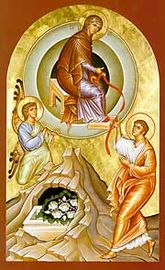Top Qs
Timeline
Chat
Perspective
August 31 (Eastern Orthodox liturgics)
From Wikipedia, the free encyclopedia
Remove ads
August 30 - Eastern Orthodox liturgical calendar - September 1

All fixed commemorations below celebrated on September 13 by Eastern Orthodox Churches on the Old Calendar.[note 1]
For August 31st, Orthodox Churches on the Old Calendar commemorate the Saints listed on August 18.
Saints
- Holy 7 Virgin-martyrs, at Gaza, by the sword.[1][2]
- Holy 4 Martyrs, at Perge in Pamphylia, by fire.[2][3]
- Holy 366 Martyrs, at Nicomedia, by the sword.[2][4]
- Martyr Phileortus, by the sword.[2][5]
- Martyrs Menas, Faustus, Andrew and Heraclius.[2][6] (see also: July 12)
- Saint Diadochos.[2][7]
- Saint Gennadius, Patriarch of Constantinople (471)[2][8][9] (see also: November 17[10] )
Pre-Schism Western saints
- Hieromartyr Cyprian, Bishop of Carthage (258)[8][11][12][note 2]
- Martyrs Caesidius and Companions, on the shores of Lake Fucino in Italy (3rd century)[12][13]
- Martyrs Robustian and Mark, venerated in Milan in Italy from early times.[12][13]
- Saint Paulinus, Bishop of Trier (358)[8][12][note 3]
- Saint Optatus, Bishop of Auxerre in France (c. 530)[12][13]
- Saint Barbolenus, fourth Abbot of Bobbio Abbey in Italy (c. 640)[12]
- Saint Eanswythe (Eanswith), Abbess of Folkestone (c. 640)[12][14][note 4]
- Saint Aidan, Bishop of Lindisfarne, Enlightener of Northumbria (651)[8][12][15][16]
- Saints Cuthburgh (Cuthburga)[17] and Cwenburgh, sisters, Abbesses of Wimborne (c. 725)[12][note 5]
- Saint Wala of Corbie, abbot of Corbie (836)[18]
Remove ads
Post-Schism Orthodox saints
- Saint John Prodrom, Metropolitan of Kiev (1089)[2][8][note 6]
- Saint Gennadius Scholarius (Gennadius the Scholar), Patriarch of Constantinople (1372)[2][8][20]
New martyrs and confessors
Other commemorations
Icon gallery
- Miracle of Cincture (Greece, 17th century).
- Saint Aidan, Bishop of Lindisfarne, Enlightener of Northumbria.
- Gennadios II Scholarios - Fresco from the monastery "St. John the Baptist" near Serres, Greece.
Remove ads
Notes
- The notation Old Style or (OS) is sometimes used to indicate a date in the Julian Calendar (which is used by churches on the "Old Calendar").
The notation New Style or (NS), indicates a date in the Revised Julian calendar (which is used by churches on the "New Calendar"). - Thascius Cecilianus Cyprianus was born in North Africa. He became a lawyer, was converted to Orthodoxy and consecrated Bishop of Carthage in 248. He wrote numerous treatises on theological subjects, one of the most important being De Unitate Catholicae Ecclesiae, and wrote numerous letters. He is one of the greatest Fathers of the Church and he was a model of compassion, discretion and pastoral zeal. Cyprian went into hiding during the persecution of Decius but was arrested and beheaded under Valerian.
- Born in Gascony in France, he accompanied St Maximinus to Trier in Germany and succeeded him as bishop in 349. He was a brave supporter of St Athanasius and was therefore exiled to Phrygia by the Arian Emperor Constantius in 355. He died in exile but his relics were brought back to Trier in 396.
- Granddaughter of King Ethelbert of Kent. She founded the first convent in England on the coast near Folkestone. This was later destroyed by the Danes and swallowed up by the sea. Relics of St Eanswith are venerated in her church in Folkestone to this day.
- Sister of King Ina of Wessex, she became a nun at Barking with St Hildelith. Together with her sister St Cwenburgh, she founded a monastery in Wimborne in Dorset, where she was abbess and was succeeded by her sister. Many nuns from Wimborne helped to enlighten Germany.
- "St. John was Metropolitan of Kiev since 1080 and soon earned general profound respect. The Venerable Nestor, his contemporary, says the following about him: "this man is an expert in books, skillful in teaching, merciful to the needy and the widows, kind to everyone, rich and poor, humble and meek". St. John died in the second half of the 11th century. He left some writings, of which the following are famous: "Message of Metropolitan John to Clement, Pope of Old Rome" and "Church Canons", written for Monk James with his explanation of the Canons of the universal (catholic) Church in their application for the Russian Church."[19]
- The restored church of the Theotokos at the Neorion (port facilities) in Constantinople, was founded by the Patrician Antonios, and stood it in the courtyard of his home. When the Patrician Antonios died, the temple was abandoned and left desolate. Later, when Emperor Romanos I Lekapenos (920-944) prepared to demolish it, the foreman in charge of the demolition of the church was physically blocked by apparitions of the Most Holy Theotokos. Therefore the decision was taken to restore the church, and by a Golden Chrysobull, an annual grant was secured for the maintenance of the church. During the restoration, the church itself received a wonder-working grace, and many miracles were experienced by many who prayed there with faith.[23]
Remove ads
References
Sources
Wikiwand - on
Seamless Wikipedia browsing. On steroids.
Remove ads






